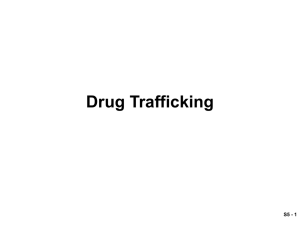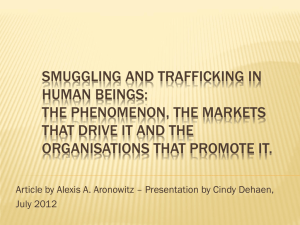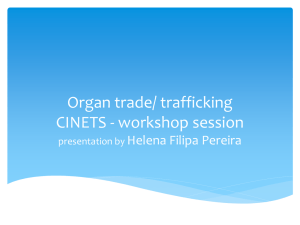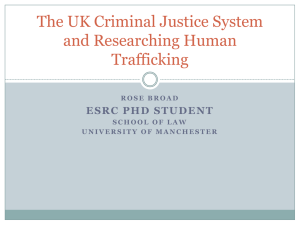USAID-The-Development-Response-to-Drug-Trafficking-in
advertisement
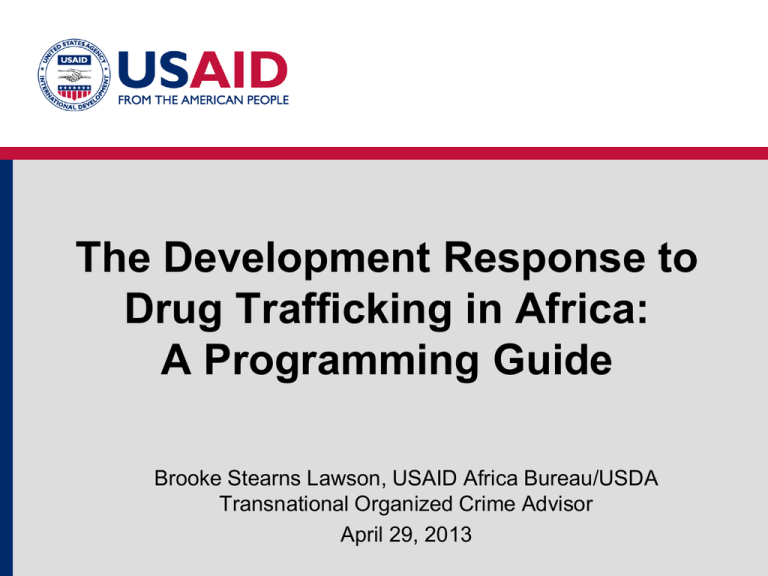
The Development Response to Drug Trafficking in Africa: A Programming Guide Brooke Stearns Lawson, USAID Africa Bureau/USDA Transnational Organized Crime Advisor April 29, 2013 Background to Programming Guide • Drug trafficking an increasing threat to development in Africa • Programming guidance to understand the relationship between drug trafficking and development assistance and mitigate negative impacts • Case studies in Ghana, Kenya, the Mano River sub-region (Guinea, Sierra Leone, and Liberia), and Mozambique • Research focus on heroin and cocaine trafficking 2 1) Drug Trafficking Threatens Development • Threats to Stability • Corrosion of Governance • Socio-Economic Impacts 3 2) Development Practitioners Must “Get Smart” on the Issue • Scope and Scale of Problem • Political Economy Analysis • Type of Approach(es) 4 3) Interdiction Alone Will Not Solve the Problem 5 4) Early Identification of the Problem and Prevention Efforts Are Critical Economic Impact Enact anti-money laundering legislation Strengthen banking, real estate and other regulations and oversight Build capacity among Financial Intelligence Units and law enforcement to analyze, target and trace financial flows Build prosecutorial capacity to freeze and seize assets and to obtain conviction and forfeitures Foster business development through regulatory and financial reform Drug Use Support clinics to treat problematic drug use Promote education to reduce demand Foster inclusion and reduce marginalization Violence Support gang prevention and rehabilitation Foster community-based citizen security Support community policing 6 5) Political Will Must Drive The Approach Opposition within Government Level of Corruption/Infiltration Low-level Officials High-level Officials Strong: High-level officials oppose state involvement in trafficking Best scenario for direct interventions Direct interventions possible but potentially destabilizing Weak: Relatively few high-level officials oppose state involvement in trafficking Direct interventions most effective when combined with increased political pressure Direct interventions not advisable 7 6) Resources Influence Programming Options Unintended Consequence Local government capacity building bolsters power of complicit officials Mitigation Approach Improve transparency or avoid local areas with known complicit officials Parliamentary transparency efforts dissuade opposition to drug trafficking Trade infrastructure development facilitates the movement of illicit goods Efforts to reduce barriers to trade facilitate the movement of illicit goods Allow private voting for drug trafficking issues Include trade regulation and controls as part of infrastructure development Identify risks and mitigation strategies with business community and transportation professionals Consider transportation methods and inspection of cargo Ensure emerging payment systems are covered by anti-money laundering regulation and entail proper supervision Require partners to develop and implement risk mitigation measures 8 Transportation of development goods is also utilized to move illicit goods Emerging payment systems facilitate the movement of drug money Drug traffickers capture humanitarian assistance 7) Change Presents Windows of Opportunity and Vulnerability 9 8) Coordination Increases Impacts Bolster Political Will Reduce tolerance through research, media Strengthen community mobilization/civil society advocacy Apply diplomatic pressure Foster Accountable Governance Streamline and improve oversight of customs, security and justice operations Strengthen accountability Increase transparency Create professional government Raise political standards Promote checks and balances through improved electoral systems Develop Counternarcotics Capacity Improve legislative framework Strengthen judicial and security institutions 10 Questions? Comments? 11



